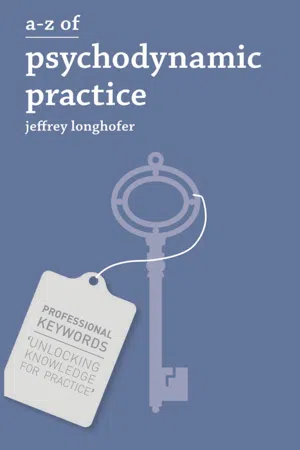
- 280 pages
- English
- PDF
- Available on iOS & Android
A-Z of Psychodynamic Practice
About This Book
If you are searching for a clear exploration of the key concepts in psychodynamic thinking and practice, then this is the book for you. In this book Jeffrey Longhofer unravels the complex field of psychodynamic practice and lays it out in an accessible A-Z format that enables any practitioner to implement psychodynamic practice into their work with people. Each entry introduces the reader to the fundamental aspects of psychodynamic practice: the theoretical underpinnings, key thinkers, debates and research. With 'Points for reflection and practice' and 'Key texts' throughout it provides clear guidance for day-to-day practice and further study. Whether you work in social work, psychology, counselling or related fields, this book will equip you with a broad knowledge of psychodynamic practice and its contribution to understanding human development.
Frequently asked questions
Information
Table of contents
- Cover
- Half-Title
- Series
- Title
- Copyright
- Dedication
- Contents
- Acknowledgements
- How to use this book
- Introduction
- adolescence
- affect
- affect regulation
- alpha and beta elements (and functions)
- ambivalence
- anxiety
- archetype
- attachment
- attacks on linking
- bad object
- body ego
- borderline
- collective unconscious
- confl ict and compromise formation
- conscious (unconscious, preconscious)
- container/contained
- countertransference
- defence mechanisms
- depression
- depressive position
- developmental stages
- diagnosis and the DSM
- dissociation
- dream
- drive
- ego
- emerging adulthood
- empathy
- envy, greed, jealousy, gratitude
- evidence-based practice
- extimacy
- fantasy (vs phantasy)
- free association
- gender
- good enough mother (holding environment)
- guilt
- identifi cation
- illusion
- imaginary
- jouissance
- listening
- mentalization
- mindfulness
- mirror stage (and mirroring)
- narcissism
- neurosis
- object
- objet a (objet petit a)
- oedipal
- paranoid–schizoid
- parapraxis
- parenting
- positivism and critical realism
- primary process and secondary process
- projection
- projective identifi cation
- psychodynamic
- psychosis
- real
- recognition
- reverie
- selfobject
- self-states
- shame
- social constructivism (or anti-essentialism)
- splitting
- sublimation
- symbolic
- symptom, symptom formation
- synchronicity
- transitional space/transitional phenomena/transitional object
- true/false self
- working alliance/therapeutic alliance
- wounded healer
- appendix 1: timeline
- appendix 2: brief biography of Freud
- appendix 3: the major psychodynamic/analytic dictionaries
- appendix 4: the defence mechanisms
- appendix 5: Erik Erikson’s developmental stages
- appendix 6: selected resources: biographies, histories, criticism, philosophy of mind
- References
- Index